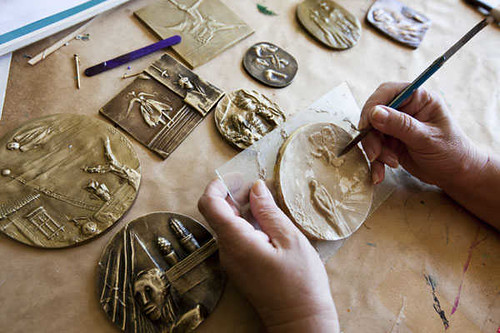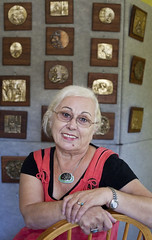
PREV ARTICLE
NEXT ARTICLE
FULL ISSUE
PREV FULL ISSUE
ARTICLE PROFILES MEDALLIC ARTIST IVANKA MINCHEVA
The Daily Press of Newport News, VA published an article this week profiling local medallic artist Ivanka Mincheva,
-Editor
Needing clay for a classroom art project, she began looking for it on her own, scouring the back lots of her concrete and brick neighborhood in urban Sofia, Bulgaria, in a single-minded pursuit of the mysterious substance. Once she found a suitably pliable puddle of mud, Mincheva reached down and began forming it into shapes with her fingers. So engrossed did she become that she couldn't stop, and she played with the wonderfully supple material for hours. More than 50 years later, the Yorktown woman is a medallic sculptor of international renown — with works in such places as the Hermitage Museum in St. Petersburg, the Pushkin Museum in Moscow and the British Museum in London. She recently won the 2010 Numismatic Art Award for Excellence in Sculpture from the American Numismatic Association. Despite her classical training, however — and years of working alongside some of medallic sculpture's most important artists — Mincheva still looks back on her unexpectedly ardent session with a Sofia mud puddle as one of her most formative moments. "My parents panicked when I didn't come home," she recalls. "When they finally found me I was still playing in the wet mud — and I still love the feeling of it today. I can't get enough."

Mincheva's training was intensive — with drawing and modeling classes every day. But after six years she graduated with such an accomplished portfolio of studio work — not to mention her exceptional knowledge of anatomy, art history and aesthetics — that she quickly became a much sought-after working artist. Within a few years, she'd won numerous commissions for monumental outdoor works commemorating her country's history and culture. But despite her growing renown for such impressive pieces, her secret passion lay in the much smaller things she habitually carved in her kitchen. "I was well-paid for these large sculptures. But I quickly realized it was not for me," she says. "I was only 110 pounds — and the biggest pieces wore me out. They also took months and months to do — and I was always struggling to put off my other ideas so I could complete them." Mincheva found the answer to her dilemma when friends introduced her to a Russian-trained Bulgarian artist who excelled at small-scale medallic sculpture. Soon she ranked alongside him in this intimate yet compelling art form, earning a place at a 1982 international symposium that exposed her distinctive, often haunting images to critics, collectors and museums across Europe. Soon her medals were being celebrated by such authorities as British art historian Terence Mullaly, who tapped a 1988 work titled "The Visitor" as one of the finest examples of the form created in the late 1900s. Sir Mark Jones, former curator at the British Museum and then director of the Victoria and Albert Museum in London, admired Mincheva's distinctive talent just as strongly. "Her hauntingly poetic and beautifully modeled medals make a deep and resonant impact on those who are lucky enough to see or, better still, handle them," he wrote. Despite the subsequent stream of commissions and awards, Mincheva's artistic and financial success couldn't compensate for a lingering sense of incompleteness. For years she had been waiting for a man, she says, and many of her images — including "The Visitor" — reflect her loneliness. That pain came to an end when she began receiving letters of admiration from a Bulgarian-born American musician who played violin for the Virginia Symphony in Norfolk. "It was instant chemistry," she says, describing months of increasingly ardent correspondence and finally meeting at the opening of one of her shows in London. "We were married in 1992 and lived in Bulgaria for a year. Then he became homesick for the States," Mincheva says. "My friends told me I was crazy to leave. I was somebody in Bulgaria, and when I came here I had to start from scratch. It was quite a culture shock." "People here don't know this kind of art well. But they show their appreciation more openly — and that's been very inspiring. It's given me more freedom in my work," she says. "I'm an American sculptor now."

"Daedalus and Icarus"
To read the complete article, see:
Yorktown woman wins world renown for medallic sculpture
(www.dailypress.com/entertainment/galleriesandmuseums The Numismatic Bibliomania Society is a non-profit organization promoting numismatic literature. See our web site at coinbooks.org. To submit items for publication in The E-Sylum, write to the Editor at this address: whomren@gmail.com To subscribe go to: https://my.binhost.com/lists/listinfo/esylum All Rights Reserved. NBS Home Page Contact the NBS webmaster 
|
